The term “ambush marketing” was first coined during the 1984 Los Angeles Summer Olympic Games. The featured combatants were official film sponsor Fuji, a tremendous coup for a Japanese company seeking to establish a U.S. toehold, and the venerable Kodak.
The background of “what really happened” is found within the boxes of the Mark H. McCormack Collection housed in the Special Collections Department, University of Massachusetts Amherst Libraries. A series of memos recently uncovered cast an intriguing light on tactics used by IMG in its early years of representing Kodak’s sport sponsorship interests. Especially illuminating are documents that recount Fuji’s incursion into the U.S. marketplace (you’ll marvel at the costs of sponsorships back then), and Kodak’s very real concerns with Fuji’s newfound emphasis on sports sponsorships.
These materials present an incomplete look into the ongoing relationship and activities between IMG and Kodak; surely, there were additional memos and conversations that fleshed out more of the details. The gist of what has been found does, however, reflect Kodak’s strategic efforts to counter Fuji’s official sponsorship of the 1984 Games and the 1986 World Cup. A peek into the McCormack Collection is particularly apropos with another Olympic Games underway and World Cup just around the corner.
 |
Kodak’s presence was ubiquitous at the 1984 track and field Olympic trials in Los Angeles.
Photo by: GETTY IMAGES
|
In a July 8, 1983, internal memo from a high-ranking Kodak executive addressed to “Consumer-KBU Managers and Advertising Managers,” he announces that Kodak will be “using IMG to help establish an overall Kodak sports strategy of an international or regional scale over the coming months.” This five-page memo, snippets of which are shared below, illuminate Kodak’s early observations about the increasing threat posed by Fuji:
In any evaluation of Fuji on a worldwide basis, it is evident that they buy distribution and use price as an incentive for consumer trial until their sales level is sufficient to support consumer advertising … The precedents of other countries tells us that Fuji’s primary point of entry is the 35mm user … The next step is for Fuji to develop target market awareness … credibility as a legitimate alternative to Kodak … To build positive brand personality, Fuji has chosen to link its brand with the positive image of sports [This memo then lists Fuji’s recent activities, including official film of the 1984 Los Angeles Olympic Games and World Cup Soccer, among others.].
What can Kodak do?
… We must recognize what we cannot do. We cannot stop Fuji from spending excessive amounts of money to buy certain sponsorships. We can preempt them from sponsorships that Kodak considers key and we can make it difficult, and expensive, for Fuji to buy major sponsorships …
What we can do is minimize the mileage Fuji gains from these substantial sports investments …
Shortly thereafter, an IMG executive sent a five-page letter to his Kodak client, detailing Fuji’s involvement as the official film sponsor of the 1986 World Cup (to be hosted by Mexico), the status of television rights, and IMG’s recommended tactics. And I quote:
C. IMG Observation
It is our opinion that the Fuji commitment represents a significant attempt to generate worldwide visibility and awareness … they can be expected to aggressively merchandise their affiliations … Kodak is therefore faced with several options: (a) to attempt to blunt the Fuji effort worldwide; (b) to take advantage of available opportunities which exist in soccer outside of the World Cup in strategic markets only to create a well-conceived presence in soccer; (c) to purchase television advertising in key countries; or (d) do nothing … Given these options, it is IMG’s recommendations that a combination of (b) and (c) be considered for discussion …
The memo continues …
D. Opportunities
There are several opportunities available to Kodak which could be used in key markets to blunt [there’s that word again] Fuji’s activities.
Opportunities identified by IMG included:
■
Affiliation with national federations
■
Involvement in World Cup Qualifying: “These qualifying games are not covered under the Fuji arrangement.”
■
Creation of youth-oriented programs
■
Outdoor advertising: “To create a visible presence for Kodak in all the World Cup qualifying cities, Kodak could reserve (as it has done in Los Angeles for the Olympics) the most prominent outdoor signage locations.”
■
Television advertising: “In the U.S., the agency should approach NBC and determine the exact conditions under which Fuji’s option exists and determine on what date the option must be exercised.”
Another document from IMG to Kodak, titled “1983 Sports Event Flex Spending Recommendation — Pacific Southern Region,” outlined opportunities in advance of the 1984 Games through which Kodak could gain “significant promotional presence” in the Los Angeles market to combat Fuji.
The first opportunity recommended was the Los Angeles Times International Track Meet:
It will be the only opportunity for foreign track and field teams to compete at the 1984 Olympic site prior to the Olympics themselves … IMG has negotiated an option for Kodak to be the photographic category sponsor of the meet (as part of an overall package which includes a similar position with the 1984 L.A. Times Indoor games and major sponsorship of the 1984 Olympic trials, also scheduled for Los Angeles). … Cost in 1983 is $10,000 as a right fee.
These archival materials illuminate tactics that would soon become known as ambush marketing. Kodak achieved perhaps its greatest measure of “blunt marketing” success through sponsorship of the 1984 U.S. Olympic Track & Field Trials, which found the Los Angeles Memorial Coliseum awash in a sea of yellow-and-red banners and Kodak signage when the Fuji representatives arrived for the event.
Such activities around the 1984 Games served as the first wake-up call for major sports event organizers, who have spent the decades since devising innumerable measures to thwart ambush marketers. One is left to wonder what might have become of the concept if after the 1984 Olympics, the media, instead of embracing the pejorative term “ambush marketing,” had instead adopted a more neutral term like “blunt marketing.” These simple two words might have completely altered the dynamic for decades to come.
The materials used in this article are courtesy of the Mark H. McCormack Collection, Special Collections Department, University of Massachusetts Amherst Libraries.
Steve McKelvey (mckelvey@isenberg.umass.edu) is associate professor in the Mark H. McCormack Department of Sport Management at University of Massachusetts Amherst.





